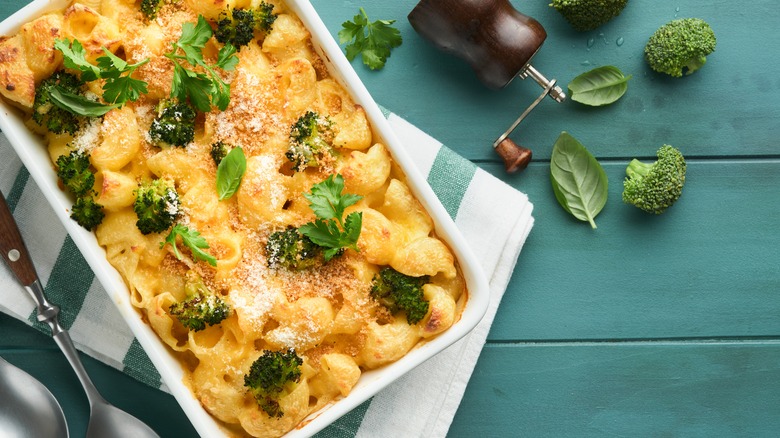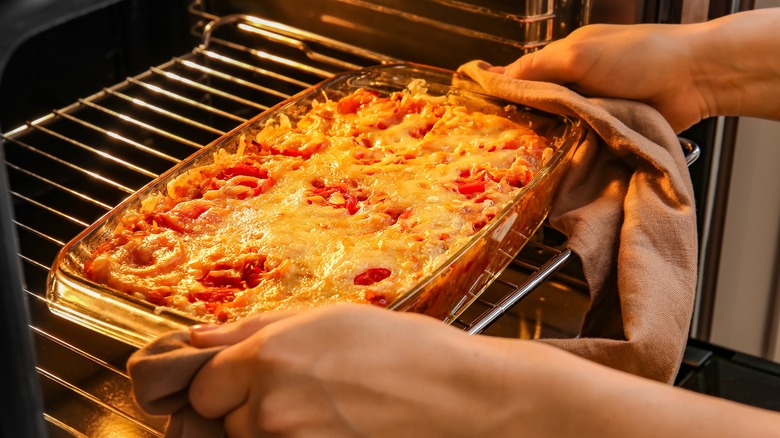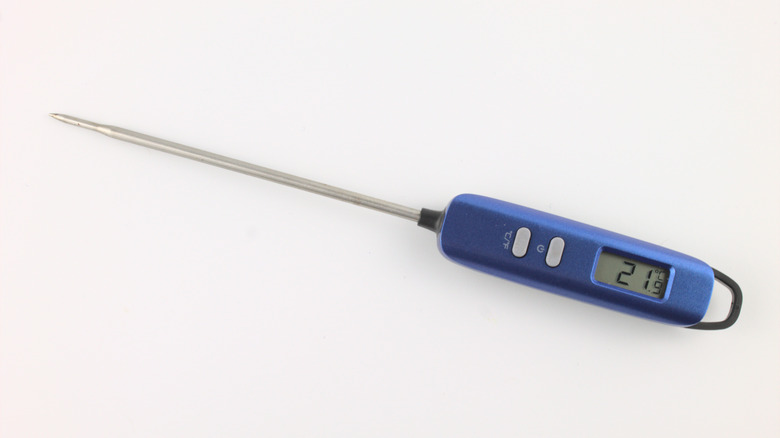The Simple Way To Tell When Your Casserole Is Fully Cooked Through
What's not to love about a good casserole? They're warm and hearty, usually come together with only a couple of steps, and you can feed a crowd of people with just one pan. Casseroles are also mostly foolproof; just assemble everything in a shallow pan and let it bake until it's cooked. But how do you know when exactly the casserole is fully finished cooking? That's the biggest question of any would-be casserole maker. If you ask your elders — many of whom passed down most of the casserole recipes to begin with — you'll get lots of advice about poking or shaking the pan. The real answer is simple, however: Just take its temperature with a thermometer. Most casseroles are cooked when they reach an internal temperature of 165 degrees Fahrenheit, and are definitely done once they reach 200 degrees.
That's not to say that you should disregard the old ways when it comes to checking on a casserole. Poking a casserole with a toothpick or a fork to see if it comes out clean is a helpful way to know what's happening in the center. Shaking the pan will also tell you if everything is cooked and set. In fact, most cooks and chefs use some combination of techniques when they're checking on casseroles — it all really depends on what's in the pan.
Use visual cues to check your casserole
Casseroles have been around a long time in some form; probably as long as we've been using pottery for cooking. After all, there's nothing easier than piling ingredients into a shallow pan and letting the oven do all the work, whether it's for breakfast, lunch, or dinner. There weren't always thermometers for testing cooked food, however, so cooks learned to test for doneness by using visual cues, and those methods have been passed down through generations.
The most common method for checking on a casserole is shaking the pan to see if the center jiggles. This is especially useful when you're making something with a loose custard, like a quiche, because the liquid will stop moving when it's set. The drawback, however, is that you have to keep checking and shaking the casserole, which means opening the oven and releasing the heat. Not only does this slow down the cooking, it's also easy to overcook the casserole if you don't catch it at just the right moment.
You can also poke the center of the casserole with a toothpick, fork, or wire cake tester and pull it out to see if it comes out clean. This technique works the same way as it does for baking a cake, and is great for something like scalloped potatoes. But unlike cakes, poking is not a great method if you're baking a casserole with lots of sticky ingredients like cheese.
Always double check with a thermometer
The safest way to know if any casserole is cooked is to check it with a quick-read thermometer. If you don't have one, you should definitely invest in one, because it will save you a lot of trouble whether you're cooking meat, bread, or even baked potatoes. All you have to do is stick the probe of the thermometer into the center of the casserole to get a temperature, which only takes a couple of seconds. The USDA says that food is generally safe to eat when it reaches an internal temperature of 165 degrees Fahrenheit, but some foods, like baked goods, need to reach around 200 degrees before they're totally cooked and ready to eat (via Real Simple).
Getting the center of a casserole cooked takes more than just heat, however. Make sure you always bake it at the temperature recommended in the recipe, which is usually slow and low. If you try to turn the oven up too hot, you can burn the outside of the food while the center stays cold and uncooked. Also, if your casserole is pre-frozen, make sure it's thawed overnight in the refrigerator before you bake it so that it cooks evenly. Keep your thermometer handy and check on your food when things start bubbling and browning, and you'll always get a perfectly cooked casserole.


